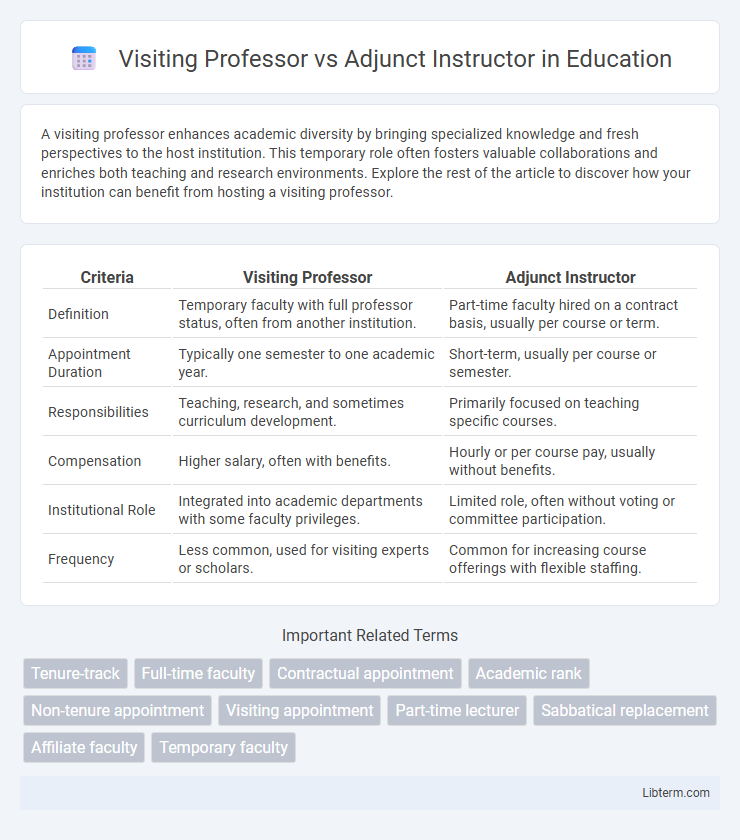A visiting professor enhances academic diversity by bringing specialized knowledge and fresh perspectives to the host institution. This temporary role often fosters valuable collaborations and enriches both teaching and research environments. Explore the rest of the article to discover how your institution can benefit from hosting a visiting professor.
Table of Comparison
| Criteria | Visiting Professor | Adjunct Instructor |
|---|---|---|
| Definition | Temporary faculty with full professor status, often from another institution. | Part-time faculty hired on a contract basis, usually per course or term. |
| Appointment Duration | Typically one semester to one academic year. | Short-term, usually per course or semester. |
| Responsibilities | Teaching, research, and sometimes curriculum development. | Primarily focused on teaching specific courses. |
| Compensation | Higher salary, often with benefits. | Hourly or per course pay, usually without benefits. |
| Institutional Role | Integrated into academic departments with some faculty privileges. | Limited role, often without voting or committee participation. |
| Frequency | Less common, used for visiting experts or scholars. | Common for increasing course offerings with flexible staffing. |
Definition of Visiting Professor
A Visiting Professor is a temporary faculty member invited to teach or conduct research at a host institution, often holding a permanent position elsewhere. They typically have advanced academic credentials, extensive research experience, and contribute specialized knowledge during their appointment. In contrast, an Adjunct Instructor usually serves on a part-time basis without a long-term commitment or substantial research responsibilities.
Definition of Adjunct Instructor
An adjunct instructor is a part-time educator hired on a contractual basis to teach specific courses without being a full-time faculty member. Unlike a visiting professor, who typically holds a temporary full-time appointment and often brings specialized expertise from another institution, adjunct instructors usually balance teaching with other professional commitments. Their roles primarily focus on delivering course content and supporting student learning within their subject area.
Key Roles and Responsibilities
Visiting Professors primarily engage in delivering specialized courses, conducting research, and contributing to academic scholarship within a limited-term appointment. Adjunct Instructors focus mainly on teaching non-tenure track courses, often part-time, with responsibilities centered on course preparation, instruction, and student assessment. Both roles support institutional teaching needs but differ in scope, research expectations, and appointment duration.
Qualifications and Requirements
Visiting Professors typically hold a Ph.D. or terminal degree in their field, demonstrating extensive academic research and teaching experience, often with a record of published work. Adjunct Instructors may possess a master's degree or equivalent professional expertise, emphasizing practical experience over scholarly achievements. Both roles require specialized knowledge, but Visiting Professors are usually engaged for limited terms based on academic credentials, while Adjunct Instructors are part-time faculty hired to meet immediate instructional needs with flexible qualifications.
Employment Status and Contract Length
Visiting Professors typically hold full-time, temporary academic appointments often lasting one to three years, usually associated with research or specialized teaching roles. Adjunct Instructors generally work on a part-time basis with short-term contracts, frequently renewed semester by semester based on course needs. Employment status for Visiting Professors usually includes more institutional benefits compared to the limited or no benefits common for Adjunct Instructors.
Salary and Benefits Comparison
Visiting Professors typically receive higher salaries than Adjunct Instructors due to full-time commitments and specialized expertise, with average annual pay ranging from $60,000 to $90,000 compared to $20,000 to $40,000 for adjunct roles. Benefits for Visiting Professors often include health insurance, retirement plans, and paid leave, whereas Adjunct Instructors usually receive minimal or no benefits. Budget constraints and contract terms significantly influence the discrepancy in compensation and benefits between these two academic positions.
Teaching Load and Academic Involvement
Visiting Professors typically carry a heavier teaching load, often responsible for multiple courses or full semesters, reflecting their temporary yet comprehensive engagement with the institution. Adjunct Instructors usually handle fewer courses per term, focusing primarily on teaching rather than research or service commitments. Visiting Professors often participate more actively in departmental activities and academic committees, while adjunct roles are generally limited to instructional duties with minimal involvement in broader academic governance.
Research Opportunities and Expectations
Visiting Professors often engage in significant research activities, contributing to ongoing projects and collaborating with faculty, which enhances both institutional knowledge and personal academic portfolios. Adjunct Instructors primarily focus on teaching responsibilities with limited research expectations, generally lacking access to the resources and support necessary for extensive scholarly work. Research opportunities for Visiting Professors usually include grant applications, lab access, and publication prospects, while Adjunct Instructors typically have minimal involvement in research initiatives.
Career Advancement Prospects
Visiting Professors often hold temporary positions at universities, primarily enhancing their academic portfolios through research and teaching opportunities, which can lead to tenure-track roles or full-time faculty appointments. Adjunct Instructors typically work part-time with limited benefits, focusing on teaching rather than research, which may restrict long-term career advancement within academia. Professionals aiming for tenure or permanent academic positions generally benefit more from the Visiting Professor role due to its potential for greater institutional involvement and scholarly development.
Choosing Between Visiting Professor and Adjunct Instructor
Choosing between a Visiting Professor and an Adjunct Instructor depends on factors like contract length, responsibilities, and institutional goals. Visiting Professors often hold temporary full-time positions with a focus on research and teaching, while Adjunct Instructors usually work part-time, primarily focusing on teaching specific courses. Evaluating workload, job security, and career objectives helps determine the best fit for academic roles.
Visiting Professor Infographic

 libterm.com
libterm.com